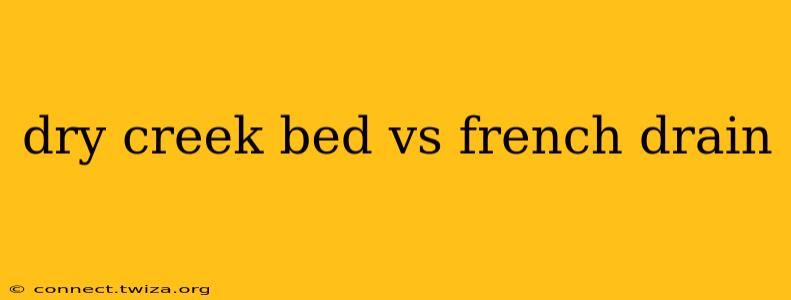Choosing between a dry creek bed and a French drain often arises when addressing drainage issues or simply enhancing the aesthetic appeal of a landscape. Both systems manage water effectively, but they serve different purposes and have distinct characteristics. This comprehensive guide will help you understand the key differences and determine which solution best suits your needs.
What is a Dry Creek Bed?
A dry creek bed is an aesthetically pleasing landscaping feature designed to mimic a natural creek or streambed. It's essentially a decorative channel constructed using rocks, gravel, and sometimes plants, to guide water away from problem areas. While it can handle some water runoff, its primary function is not solely drainage. It's more about improving the landscape's visual appeal while subtly managing minor water flow.
Advantages of a Dry Creek Bed:
- Enhanced Landscaping: Dry creek beds dramatically improve the aesthetic appeal of a yard, adding a natural, visually interesting element.
- Erosion Control: They help prevent soil erosion by directing water flow away from vulnerable areas.
- Water Diversion: They can effectively channel small amounts of runoff, preventing pooling or flooding in unwanted locations.
- Low Maintenance: Once established, they require minimal upkeep.
Disadvantages of a Dry Creek Bed:
- Limited Drainage Capacity: Dry creek beds are not suitable for large volumes of water or significant drainage issues. Heavy rainfall can overwhelm the system.
- Potential for Clogging: Debris can accumulate, potentially clogging the flow path.
- Not Ideal for Steep Slopes: On steep slopes, water might erode the bed more quickly.
What is a French Drain?
A French drain is a subsurface drainage system primarily designed for effective water management. It consists of a perforated pipe surrounded by gravel, buried beneath the ground. This system collects and redirects subsurface water, preventing waterlogging and potential damage to foundations or landscaping.
Advantages of a French Drain:
- Superior Drainage: French drains handle substantial amounts of water, effectively addressing serious drainage problems.
- Prevents Waterlogging: They keep underground water levels down, protecting structures and plant life.
- Long-lasting Solution: When properly installed, they provide a long-term solution to drainage challenges.
- Concealed System: Unlike dry creek beds, they are primarily underground and invisible.
Disadvantages of a French Drain:
- Higher Installation Cost: French drains are more expensive to install than dry creek beds, requiring excavation and specialized materials.
- Maintenance: While generally low-maintenance, occasional cleaning or repairs might be necessary.
- Less Aesthetically Pleasing: French drains lack the visual appeal of a dry creek bed.
Dry Creek Bed vs. French Drain: Which One is Better?
The best choice depends entirely on your specific needs and circumstances.
-
Choose a dry creek bed if: You primarily want to enhance the aesthetics of your yard, manage minor water runoff, and have a relatively flat landscape with manageable drainage issues.
-
Choose a French drain if: You need to address significant drainage problems, prevent water damage to structures, or have a steeply sloped property with substantial water runoff.
What are the different types of dry creek beds?
Dry creek beds can vary in design, incorporating different materials and styles to suit the surrounding landscape. Some might incorporate meandering paths, while others are straighter and more linear. The choice of rocks and gravel also affects the overall appearance, with options ranging from smooth river stones to rougher, more rustic materials. The inclusion of drought-tolerant plants can further enhance the natural look and potentially help with some water absorption.
What is the best way to maintain a dry creek bed?
Maintaining a dry creek bed involves periodic checks to ensure the free flow of water. Debris can build up over time, and occasionally cleaning might be necessary to prevent clogging. Inspect the rockwork for any shifting or erosion. If using plants, ensure they are healthy and appropriately spaced.
How much does it cost to install a dry creek bed or French drain?
The cost varies significantly based on factors like the size of the project, the type of materials used, and labor costs. French drains are generally more expensive due to the excavation and specialized materials involved. It’s always advisable to obtain multiple quotes from reputable contractors.
How long do dry creek beds and French drains last?
With proper installation and maintenance, both dry creek beds and French drains can last for many years. The lifespan of a dry creek bed is largely determined by the materials used and how well it handles water flow. French drains, when installed correctly, are exceptionally durable.
This in-depth comparison should provide a solid understanding of the differences between dry creek beds and French drains. Remember to consider your specific circumstances and consult with a landscaping professional for personalized advice before making a decision.
